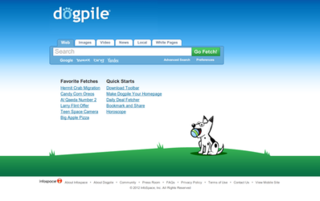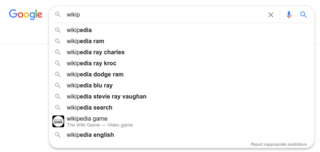Related Research Articles
In computing, a search engine is an information retrieval software system designed to help find information stored on one or more computer systems. Search engines discover, crawl, transform, and store information for retrieval and presentation in response to user queries. The search results are usually presented in a list and are commonly called hits. The most widely used type of search engine is a web search engine, which searches for information on the World Wide Web.

A Web crawler, sometimes called a spider or spiderbot and often shortened to crawler, is an Internet bot that systematically browses the World Wide Web and that is typically operated by search engines for the purpose of Web indexing.
Spamdexing is the deliberate manipulation of search engine indexes. It involves a number of methods, such as link building and repeating unrelated phrases, to manipulate the relevance or prominence of resources indexed in a manner inconsistent with the purpose of the indexing system.
WebCrawler is a search engine, and one of the oldest surviving search engines on the web today. For many years, it operated as a metasearch engine. WebCrawler was the first web search engine to provide full text search.
A web directory or link directory is an online list or catalog of websites. That is, it is a directory on the World Wide Web of the World Wide Web. Historically, directories typically listed entries on people or businesses, and their contact information; such directories are still in use today. A web directory includes entries about websites, including links to those websites, organized into categories and subcategories. Besides a link, each entry may include the title of the website, and a description of its contents. In most web directories, the entries are about whole websites, rather than individual pages within them. Websites are often limited to inclusion in only a few categories.
Search engine optimization (SEO) is the process of improving the quality and quantity of website traffic to a website or a web page from search engines. SEO targets unpaid traffic rather than direct traffic or paid traffic. Unpaid traffic may originate from different kinds of searches, including image search, video search, academic search, news search, and industry-specific vertical search engines.

On the World Wide Web, a link farm is any group of websites that all hyperlink to other sites in the group for the purpose of increasing SEO rankings. In graph theoretic terms, a link farm is a clique. Although some link farms can be created by hand, most are created through automated programs and services. A link farm is a form of spamming the index of a web search engine. Other link exchange systems are designed to allow individual websites to selectively exchange links with other relevant websites, and are not considered a form of spamdexing.

Googlebot is the web crawler software used by Google that collects documents from the web to build a searchable index for the Google Search engine. This name is actually used to refer to two different types of web crawlers: a desktop crawler and a mobile crawler.

Dogpile is a metasearch engine for information on the World Wide Web that fetches results from Google, Yahoo!, Yandex, Bing, and other popular search engines, including those from audio and video content providers such as Yahoo!.

A metasearch engine is an online information retrieval tool that uses the data of a web search engine to produce its own results. Metasearch engines take input from a user and immediately query search engines for results. Sufficient data is gathered, ranked, and presented to the users.
ALIWEB is considered the second Web search engine after JumpStation.

YaCy is a free distributed search engine built on the principles of peer-to-peer (P2P) networks, created by Michael Christen in 2003. The engine is written in Java and distributed on several hundred computers, as of September 2006, so-called YaCy-peers. Each YaCy-peer independently crawls through the Internet, analyzes and indexes found web pages, and stores indexing results in a common database which is shared with other YaCy-peers using principles of peer-to-peer.

A search engine is a software system that provides hyperlinks to web pages and other relevant information on the Web in response to a user's query. The user inputs a query within a web browser or a mobile app, and the search results are often a list of hyperlinks, accompanied by textual summaries and images. Users also have the option of limiting the search to a specific type of results, such as images, videos, or news.
A vertical search engine is distinct from a general web search engine, in that it focuses on a specific segment of online content. They are also called specialty or topical search engines. The vertical content area may be based on topicality, media type, or genre of content. Common verticals include shopping, the automotive industry, legal information, medical information, scholarly literature, job search and travel. Examples of vertical search engines include the Library of Congress, Mocavo, Nuroa, Trulia, and Yelp.
WWWW may refer to:
Search engine indexing is the collecting, parsing, and storing of data to facilitate fast and accurate information retrieval. Index design incorporates interdisciplinary concepts from linguistics, cognitive psychology, mathematics, informatics, and computer science. An alternate name for the process, in the context of search engines designed to find web pages on the Internet, is web indexing.
BotSeer was a Web-based information system and search tool used for research on Web robots and trends in Robot Exclusion Protocol deployment and adherence. It was created and designed by Yang Sun, Isaac G. Councill, Ziming Zhuang and C. Lee Giles. BotSeer was in operation from 2007 to 2010, approximately.
Twing.com was a search engine before the end of 2008 specializing in internet forum content, located in Jersey City, New Jersey, with data centers around the world. Twing.com used vertical searching as a forum search service that seeks out communities based on common forum formats. The product disappeared from the Web in late November, 2008, when the product division's parent company Accoona ceased business operations.

JumpStation was the first WWW search engine that behaved, and appeared to the user, the way current web search engines do. It started indexing on 12 December 1993 and was announced on the Mosaic "What's New" webpage on 21 December 1993. It was hosted at the University of Stirling in Scotland.
References
- ↑ SEO, Doctor (2022). "Evolution of SEO". www.doctor-seo.net.
- ↑ Matthew Gray's home page - Pertinent page on Matthew Gray's section on MIT site
- ↑ Brian LaMacchia's PhD thesis, section 1.2.3